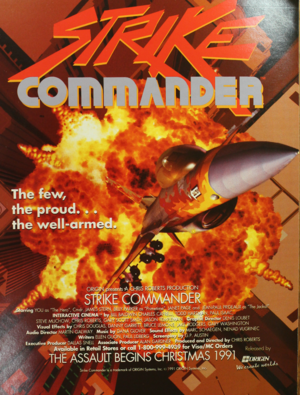
Strike Commander is a combat flight simulation video game designed by Chris Roberts and released by Origin Systems for the PC DOS in 1993.
Gameplay
Strike Commander is set in what was at the time the far future of 2011, where after a tumultuous decade society had fallen appart and corporations became more powerful and routinely hired mercenary jet fighter squadrons to fight for territory and resources.[1][2]
The player is second in command at the Wildcats sqaudron which is unique as only accepting missions which aren’t immoral.[2]
The game was a Hollywood-style action blockbuster with the player as the lead character, with a strong story told largely via between-mission dialog scenes, patterned after the great military action movies of the 1980s such as top gun: F-16s battling in the skies against other familiar modern aircraft, a father figure to avenge, a beautiful seductress with a hidden agenda, friends going separate ways over morals and eventually fighting each other… and rendered cutscenes that strove for the proper atmosphere as much as they did high tech polish.[1][3]
Development
Chris Roberts wanted to take the Wing Commander presentation and storytelling further in a different setting.
Strike Commander was over budget and overdue, in large part due to Chris Roberts constantly updating his engine to take advantage of the latest cutting-edge hardware to make it look spectacular, with the game’s gestation time of two and a half years being absurdly long by the standards of the early 1990s. Nevertheless, successful gameplay elements from Strike Commander were re-used by other more notable Origin products such as Privateer and the Wing Commander series. Chris Roberts, in the game's manual, compares the game's long development time with the events in the 1991 documentary Hearts of Darkness: A Filmmaker's Apocalypse, a film account of what it took to get the 1979 film Apocalypse Now made. Strike Commander was a financial fiasco for Origin: while a great game, too many delays, exaggerated requirements, and pressure to get it out as soon as possible from Electronic Arts made the product clumsy and lacking in Roberts' polished style. In hindsight, Chris Roberts declared that the game maybe wasn't as apocalyptic as he had thought at the time.[1]
F16 veterans pilots that flew in the Gulf War had given feedback during development and the game was more accurate than Falcon 3.0.[1]
The 2D sprites were gone and the game is in full 3D with real texture mapping.[2] Its 3D graphics-engine used both gouraud shading and texture-mapping on both aircraft-models and terrain, an impressive feat at the time which wasn't reiterated until Quake.[1]
One of Strike Commander’s innovations was the inclusion of a virtual cockpi’ where the player’s head and the environment could be controlled separately. Players could look around freely in any direction rather than just left, right, forward and backwards.[4]
Strike Commander supposed the abandonment of the 386 processor by Origin Systems, the game is absolutely excessive in everything and although it runs on the aforementioned processor, a 486 was necessary to make it work well. It required eight 3 ½" floppy disks, four megabytes of RAM and an installation time of half an hour to an hour, and once unpacked the game with speech pack came to about 45 Mb in an era when most gamers didn’t even have a hard disk that big.[2]
When it came out this was probably the most hardware-intensive game yet released.[5] Origin had to admit in their newsletter that customers had been “stunned” by the hardware Strike Commander craved.[6]
The technology that had been developped for Strike Commander ended up being used in a number of subsequant Origin games such as WIng III and Wing IV and Pacific Strike, Wings of Glory, Armada and more.[7][1]
Strike Commander was re-released in 2013 on Gog.com with support for Windows and macOS.
Quote
"Doing R&D tech design on stuff that no one else has done before is harder than you normally think it is." -Chris Roberts[1]
Trivia
- Rob Irving was Technical Design Assistant, similar to today's Level Designer.[8][1]
- David Ladyman worked on the game manual and guide.
- Erin Roberts also worked on the game.[9][10]
- Characters are modelled after well known actors, and Chris Roberts tried to have Mel Gibson voice the lead, at a time where he hadn't yet become controversial.[1]
External Links
References
- ↑ 1.0 1.1 1.2 1.3 1.4 1.5 1.6 1.7 1.8 RSI Museum ep01 . Strike Commander, Star Citizen, YouTube, 7 Jun 2013
- ↑ 2.0 2.1 2.2 2.3 Day 103 – Strike Commander, Pix's Origin Advnetures, October 22, 2008
- ↑ Blast from the Past: Strike Commander. Spectrum Dispatch - Comm-Link. Retrieved 2012-09-21
- ↑ Wingman's Hangar ep058 . February 26, 2014, Star Citizen, YouTube
- ↑ "In Search Of... The Ultimate Game Machine". Computer Gaming World. pp. 83–85. Retrieved 29 March 2016.
- ↑ Origin Sells Out, The Digital Antiquarian, September 6, 2019
- ↑ 10 For the Chairman Episode 62, Star Citizen, YouTube, 4 Aug 2015
- ↑ Wingman's Hangar ep010 . March 1, 2013, Star Citizen, YouTube, 1 Mar 2013
- ↑ ATV Interview: Erin Roberts, Star Citizen, YouTube, 19 Apr 2016
- ↑ 10 for the Chairman: Episode 80, Star Citizen, YouTube, 29 Mar 2016
